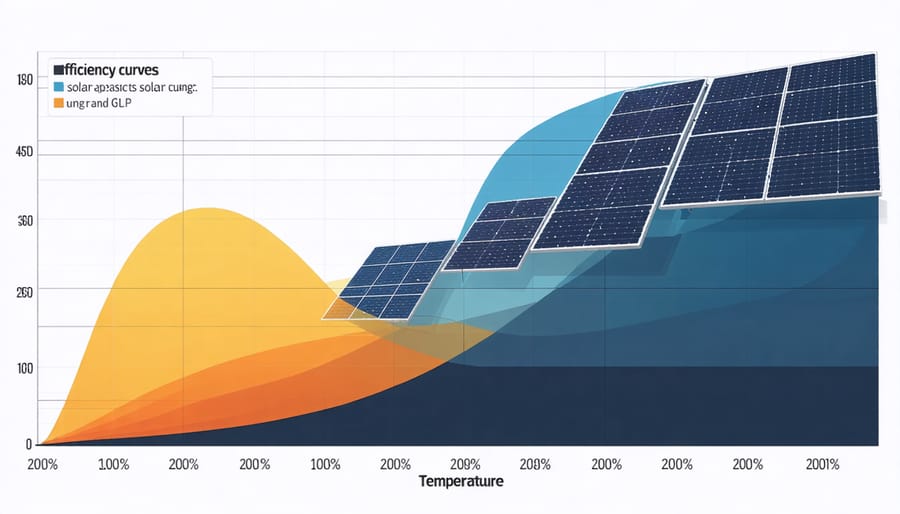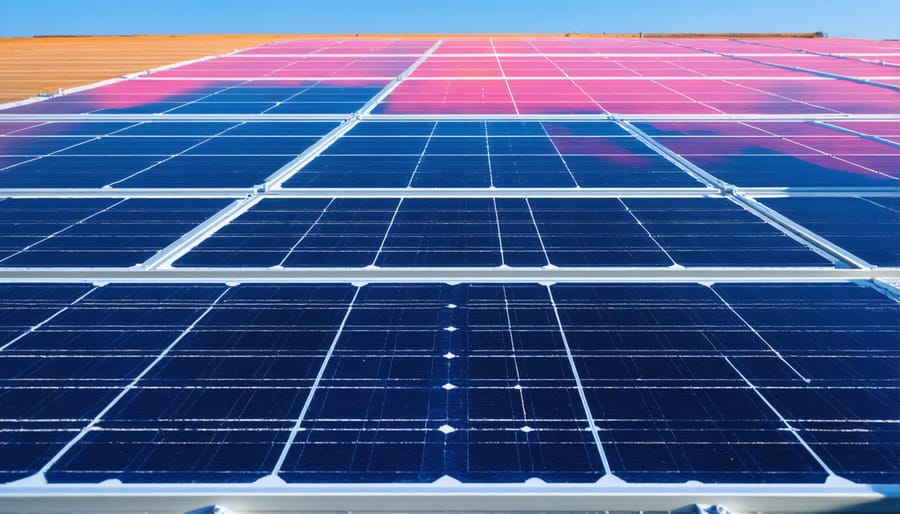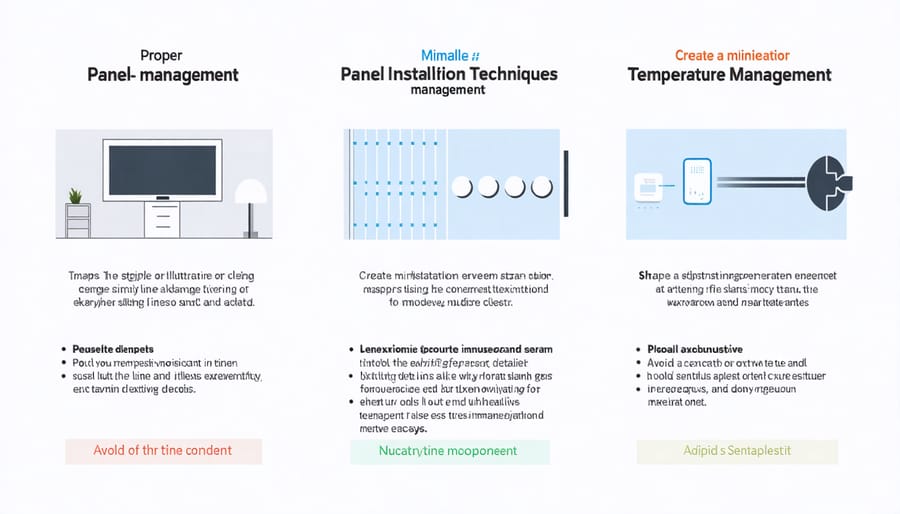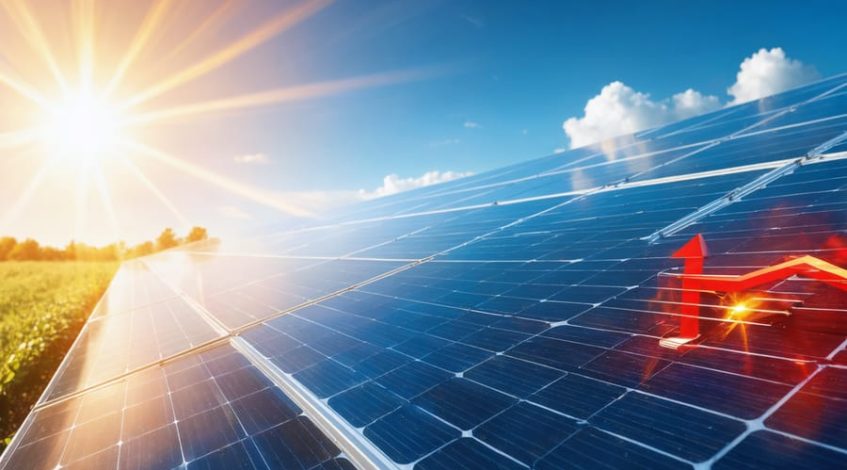Understanding the relationship between temperature and solar panel efficiency is crucial for maximizing renewable energy investments. As global temperatures continue to rise, this correlation becomes increasingly significant for energy planning and system optimization. Solar panels, while highly effective at converting sunlight into electricity, experience a notable efficiency decline as temperatures increase above their rated operating conditions.
Research demonstrates that most silicon-based solar panels lose approximately 0.4% to 0.5% efficiency for every degree Celsius rise above 25°C (77°F). This temperature coefficient, clearly visible in efficiency-versus-temperature graphs, reveals a linear decline that directly impacts power output and return on investment. For instance, a panel rated at 20% efficiency at 25°C might operate at only 18% efficiency when reaching 60°C (140°F) during peak summer conditions.
This critical relationship drives innovation in panel design, installation techniques, and cooling solutions. Forward-thinking organizations now prioritize temperature management strategies, from selecting high-temperature-resistant panels to implementing advanced cooling systems, ensuring optimal performance across diverse climate conditions. Understanding these temperature-efficiency curves enables decision-makers to make data-driven choices that maximize energy production and financial returns throughout the system’s lifetime.
Understanding the Temperature-Efficiency Relationship
The Temperature Coefficient Explained
The temperature coefficient is a critical specification that indicates how a solar panel’s power output changes with temperature variations. Typically expressed as a percentage per degree Celsius (%/°C), this coefficient represents the rate at which panel efficiency decreases as temperatures rise above the standard testing condition of 25°C (77°F).
Most crystalline silicon solar panels have a temperature coefficient between -0.3% and -0.5% per degree Celsius. For example, a panel with a -0.4%/°C coefficient will lose 0.4% of its rated power output for every degree increase above 25°C. This means that on a 35°C day, the panel could experience a 4% reduction in power output compared to its rated capacity.
Understanding temperature coefficients is essential for accurate system design and performance predictions, particularly in regions with extreme temperatures. When comparing solar panels, a lower (closer to zero) temperature coefficient indicates better high-temperature performance. Premium panels often feature superior temperature coefficients, which can justify their higher initial cost through improved energy yield in warm climates.
Optimal Operating Temperature Ranges
Different solar panel technologies exhibit distinct optimal temperature ranges for peak performance. Monocrystalline panels typically operate most efficiently between 15°C and 25°C (59°F to 77°F), while polycrystalline panels show optimal performance in slightly higher temperatures, ranging from 20°C to 30°C (68°F to 86°F). Thin-film panels demonstrate greater temperature tolerance, maintaining relatively stable efficiency up to 35°C (95°F).
For most commercial installations, maintaining panel temperatures below 30°C is ideal for maximizing energy yield. A case study from a large-scale installation in Arizona showed that panels equipped with active cooling systems maintained efficiency rates 12% higher than non-cooled panels during peak summer months.
To achieve optimal operating temperatures, facility managers should consider:
– Panel mounting systems with adequate ventilation
– Light-colored mounting surfaces to minimize heat absorption
– Strategic panel orientation to balance sun exposure and cooling
– Installation height that allows natural airflow
– Integration of cooling systems in high-temperature regions
Understanding these temperature ranges is crucial for system design and placement decisions, particularly in regions with extreme climate conditions. Regular monitoring of panel temperatures can help maintain optimal performance and extend system lifespan.

Solar Panel Types and Their Temperature Performance
Monocrystalline Panels
Monocrystalline solar panels demonstrate distinct temperature-dependent performance characteristics that make them a preferred choice for many commercial installations. These panels typically show a temperature coefficient between -0.3% to -0.5% per degree Celsius above standard testing conditions (25°C). This means for every degree increase in temperature above 25°C, the panel’s efficiency decreases by this percentage.
In real-world applications, monocrystalline panels maintain higher efficiency compared to other panel types across temperature ranges. For instance, a high-quality monocrystalline panel rated at 20% efficiency at 25°C will still operate at approximately 18.5% efficiency at 45°C. This relatively modest efficiency drop makes them particularly suitable for hot climates.
The superior temperature performance of monocrystalline panels stems from their pure silicon composition and single-crystal structure. This uniformity allows for better electron flow even at elevated temperatures. Additionally, many modern monocrystalline panels incorporate advanced temperature management features, such as PERC technology and improved cell architectures, which help mitigate efficiency losses in high-temperature conditions.
Polycrystalline Panels
Polycrystalline solar panels typically demonstrate a temperature coefficient between -0.45% and -0.50% per degree Celsius above standard test conditions (25°C). This means for every degree increase in temperature, their efficiency decreases by approximately 0.5%. In real-world applications, a polycrystalline panel rated at 17% efficiency at 25°C might operate at around 15% efficiency when the panel temperature reaches 45°C.
These panels show slightly higher temperature sensitivity compared to monocrystalline variants, making them more susceptible to efficiency losses in hot climates. However, they perform particularly well in moderate temperature conditions between 15-25°C. For installations in regions with extreme temperature variations, performance modeling should account for seasonal efficiency fluctuations of 10-15%.
Recent technological improvements have enhanced their temperature resilience, with some manufacturers achieving coefficients as low as -0.42% per degree Celsius, narrowing the performance gap with premium alternatives.
Thin-Film Panels
Thin-film solar panels demonstrate unique temperature performance characteristics that set them apart from traditional crystalline silicon panels. These panels typically show less efficiency degradation as temperatures rise, with a temperature coefficient ranging from -0.25% to -0.35% per degree Celsius. This superior heat tolerance makes them particularly suitable for hot climates and applications where panel temperatures frequently exceed 25°C.
Field studies in desert installations have shown that thin-film technologies, especially those using amorphous silicon (a-Si) and cadmium telluride (CdTe), maintain more consistent output during high-temperature conditions. For instance, a commercial installation in Arizona reported only a 10-12% efficiency drop during peak summer temperatures, compared to 15-20% for standard crystalline panels.
The enhanced temperature performance of thin-film panels can result in higher annual energy yields in warm regions, despite their lower nominal efficiency ratings. This characteristic, combined with their lower production costs, makes them an increasingly attractive option for large-scale solar installations in hot climates.
Climate-Specific Panel Selection
Hot Climate Considerations
In high-temperature regions, selecting and installing the right solar panels becomes crucial for maintaining optimal system performance. Premium monocrystalline panels with lower temperature coefficients (-0.3% to -0.4% per degree Celsius) typically offer better performance in hot climates compared to standard polycrystalline options. These panels demonstrate superior heat tolerance and maintain higher efficiency levels even during peak temperature conditions.
Installation practices significantly impact performance in hot environments. Establishing adequate airflow behind the panels through proper mounting techniques is essential. A minimum gap of 4-6 inches between the roof surface and panels allows for natural convection cooling, reducing operating temperatures by up to 20°F. Light-colored mounting equipment and frames can also help minimize heat absorption.
Recent case studies from Arizona and Texas demonstrate the effectiveness of these strategies. Facilities implementing elevated mounting systems with enhanced ventilation reported 12-15% better annual performance compared to traditional installations. Additionally, incorporating temperature-resistant inverters rated for high-heat operations ensures system-wide reliability.
For maximum hot-climate performance, consider these key factors:
– Panel orientation and tilt angles optimized for both solar exposure and heat dissipation
– High-quality components with proven heat resistance
– Regular maintenance schedules focused on cleaning and ventilation system checks
– Strategic placement avoiding heat-reflecting surfaces
– Professional installation ensuring proper spacing and airflow
These considerations, combined with careful system monitoring, help maintain optimal efficiency levels even in challenging temperature conditions, maximizing return on investment for solar installations in hot climates.

Cold Climate Solutions
For regions experiencing cold climates, selecting the right solar panels becomes crucial for maximizing energy generation. Contrary to common perception, solar panel performance in cold weather can actually be more efficient, provided the right technology is implemented.
Monocrystalline panels are particularly well-suited for cold environments due to their higher efficiency ratings and superior temperature coefficient. These panels typically demonstrate only a 0.3% to 0.4% efficiency loss per degree Celsius above standard testing conditions, making them ideal for locations with significant temperature variations.
When selecting panels for cold climates, consider:
1. Temperature Coefficient Ratings: Choose panels with lower temperature coefficients (-0.3% or better) to maintain optimal performance during seasonal changes.
2. Snow Load Ratings: Ensure panels meet local snow load requirements and feature robust frame construction to withstand winter conditions.
3. Anti-reflective Coatings: Look for panels with specialized coatings that enhance light absorption, particularly during shorter winter days.
4. Mounting Systems: Opt for adjustable racking systems that allow for steeper tilt angles to maximize winter sun exposure and facilitate snow shedding.
Modern bifacial panels have shown promising results in snowy conditions, as they can capture reflected light from snow-covered surfaces, potentially increasing overall system yield by 5-30% in winter months.
For optimal results, combine these panel selections with smart monitoring systems that can detect snow coverage and system performance variations, enabling proactive maintenance scheduling and performance optimization throughout the winter season.
Maximizing Efficiency Across Temperature Ranges

Installation Best Practices
To maximize solar panel efficiency across temperature variations, implementing proper installation techniques is crucial. Begin with optimal panel placement, ensuring adequate airflow beneath the panels through proper mounting height and spacing. A minimum gap of 4-6 inches between the roof surface and panels promotes ventilation and helps maintain lower operating temperatures.
Consider installing light-colored mounting systems and using thermal barrier materials beneath the panels to reduce heat absorption. White or reflective roof surfaces can significantly decrease ambient temperature around the installation area. For commercial installations, implementing active cooling systems or hybrid PV-thermal solutions may be cost-effective in high-temperature regions.
Orientation and tilt angles should be carefully calculated based on your geographical location and local climate patterns. In warmer climates, a slightly steeper tilt angle can improve airflow while maintaining optimal sun exposure. Integration of temperature monitoring systems enables real-time performance tracking and early detection of thermal issues.
For large-scale installations, incorporating micro-inverters or power optimizers can help minimize the impact of temperature-induced power losses by managing each panel independently. Regular maintenance schedules should include cleaning and inspection of ventilation channels to ensure consistent cooling performance throughout the system’s lifetime.
Monitoring and Maintenance Tips
Regular monitoring and maintenance are crucial for maximizing the performance of your solar installation across varying temperature conditions. Implement a comprehensive monitoring system that tracks both temperature and power output data, allowing you to identify efficiency patterns and potential issues early. Daily performance logs should include ambient temperature, panel surface temperature, and corresponding power generation metrics.
To maintain optimal efficiency, schedule quarterly inspections of your solar panels, focusing on cleanliness and physical condition. During summer months, increase inspection frequency to monthly intervals, as higher temperatures can accelerate efficiency losses. Clean panels using demineralized water and soft brushes to prevent heat-trapping dirt accumulation, which can further impact solar panel longevity.
Consider installing temperature sensors at multiple points across your array to identify hot spots and temperature variations. This data helps optimize panel positioning and ventilation systems. Maintain proper airflow beneath panels by ensuring adequate spacing during installation and regularly clearing debris from ventilation channels.
Document temperature-related performance variations seasonally to establish baseline expectations and detect anomalies quickly. Use this historical data to schedule preventive maintenance during periods of peak temperature stress. For large installations, consider implementing automated monitoring systems with alert capabilities for temperature-related efficiency drops below predetermined thresholds.
Understanding the relationship between temperature and solar panel efficiency is crucial for maximizing your renewable energy investment. As demonstrated by the efficiency-temperature curves, most solar panels experience a efficiency decrease of 0.3% to 0.5% for every degree Celsius increase above standard testing conditions (25°C). This knowledge should directly inform your panel selection process based on your specific climate conditions.
For regions with high average temperatures, we recommend prioritizing panels with lower temperature coefficients and superior heat handling characteristics. Premium monocrystalline panels with PERC technology typically offer better temperature tolerance and maintain higher efficiency in hot conditions. Conversely, if your facility operates in moderate to cool climates, standard efficiency panels may provide better ROI, as they can operate closer to their rated efficiency more consistently.
To optimize your solar installation, consider implementing active cooling systems in hot climates, ensuring proper panel ventilation, and scheduling regular maintenance to maintain peak performance. When evaluating solar proposals, request detailed temperature performance data and projected annual energy yields that account for local temperature variations.
Remember that while initial costs may be higher for temperature-resistant panels, the long-term benefits of sustained efficiency often justify the investment, particularly in regions with extreme temperature fluctuations. Work with qualified solar installers who can provide climate-specific recommendations and performance guarantees aligned with your local conditions.

